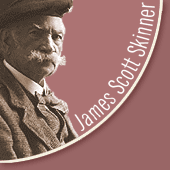




Please click any thumbnail image to view the full details.
There are 900 entries.
prev 10 | 42 > 43 > 44 > 45 > 46 > 47 > 48 > 49 > 50 > 51 | next 10 of 90 pages
| Image | Title | Item Description |
|---|---|---|
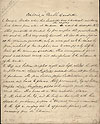 JSS0473 |
Page 1 of 2, Coulow's or Double Quadrille | This excerpt is from a series of notebooks compiled by Skinner and his own dance teacher, William Scott. The notebooks were published under the title, A Guide to Fashionable Dancing. (Being in London when this Quadrille was introduced and having had lessons from a Mrs N Henderson, the compilers insert her descriptions W.S. [William Scott]). This quadrille is danced by four couples. All quadrille music will suit it. It is very easily learned. It has the same figures as the common quadrille, only so arranged as to be danced by four, instead of two couples; and to occupy only half the time of the common quadrille. This arrangement gives great additional variety and cheerfulness to the movements of the dance. 1. Top and bottom couples right and left, whilst the side couples dance chaine Anglaise outside them. All four balance to partners. The four ladies form ladies' chain, or hands across and back to places. Half promenade, top and bottom couples chaine Anglaise, whilst side couples grands chaine round them. This leaves all in their respective places. 2. The lady at the top, and the lady on her right, with their opposite gentlemen, perform L'Ete (each forming a semicircle to the left in crossing over to opposite places). The remaining four do likewise. |
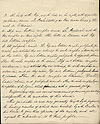 JSS0474 |
Page 2 of 2, Coulow's or Double Quadrille | This excerpt is from a series of notebooks compiled by Skinner and his own dance teacher, William Scott. The notebooks were published under the title, A Guide to Fashionable Dancing. (continued from JSS0473) 3. The lady at the top, and the lady on her right, with opposite gentlemen, dance La Poule (setting in two cross lines). The rest do likewise. 4. Top and bottom couples dance La Pastorale with the two couples on their right. The latter do likewise with top and bottom couples. 5. All galopade round. The top and bottom couples galopade forwards; and whilst they are retiring the side couples advance, and as they retire, top and bottom couples galopade to opposite places. Then the side couples do the same. Top and bottom couples readvance; and whilst they are retiring, the side couples readvance, and as they retire, top and bottom galopade back to places. Then the side couples do likewise. Double ladies' chain, and galopade round. Then the side couples begin the repetition of the figure, which finishes with a general galop. Uniformity of step and correct measurement of time are particularly indispensible in the execution of this dance. This quadrille is now very generally taught by the profession, the leading members of which were invited by M. Coulow to his house to give their opinion of its merits, and all agreed to introduce it to their pupils. |
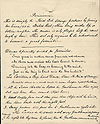 JSS0475 |
Parisienne and Dances specially suited for Juveniles | This excerpt is from a series of notebooks compiled by Skinner and his own dance teacher, William Scott. The notebooks were published under the title, A Guide to Fashionable Dancing. Parisienne This is simply the First Set. Arrange partners by forming two lines (as in Scotch reel). There being neither top or bottom couples. The music is only played half the usual length of time. This set only requires to be introduced to become a great favourite. Dances specially suited for Juveniles 'True grace in motion comes from art, not chance, As those move easiest who have learnt to dance; Dancing is to the body as learning to the mind, Just as the twig is bent so is the tree inclin'd.' La Corrillion or Clap-hand Dance. Tune - The Prince of Orange. The couples stand in a circle round the room. Lady on right of Gentleman. 1. All the Ladies Chasse in before the Gentlemen on their right. Set and turn them round. (Eight bars) 2. Couples face each other, give three claps with the hands, then three beats with the right foot. 3. Swing partner and pass her to Gentleman on right side. The Ladies do the same with every Gentleman and moving round to the right till they come to places; then the Gentlemen commence and do the same. |
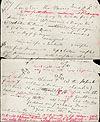 JSS0476 |
Long Live the Queen Quadrille CD | This excerpt is from a series of notebooks compiled by Skinner and his own dance teacher, William Scott. The notebooks were published under the title, A Guide to Fashionable Dancing. Long live the Queen Quadrille CD [Country Dance] By Mr Scott Skinner, as danced at Balmoral. Music - 16 bars of any 6/8 Quadrille fig: for Promenade and (1) Bonnie Wood o' Craigie Lea, (2) God bless the Prince, (3) Auld Lang syne & God save the Queen as chausses,all in Key of G major. Arrangement Same as for a Quadrille 8 couples (/S) All full promenade top & bottom couples Full promenade - side couples do Then form four stars as under: [arrangement of couples shown]. Count eight each way crossing with right and left hand [the rest of the arrangement of couples is illustrated], and introduce chaines (1) then repeat from (/S) 2nd time introducing chorus (2). 3rd time chorus (3) after which all the ladies join hands in centre & all Gentlemen do. encircling them all sing while standing 'God save our Gracious Queen Long live our noble Queen God save the Queen - All the ladies still join hands galop quickly to left to places. Gents do. to right to places to tune of 'Flowers of Edinburgh - places. All catch their partners & galop quickly to places. |
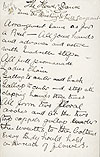 JSS0477 |
The Flower Dance | This excerpt is from a series of notebooks compiled by Skinner and his own dance teacher, William Scott. The notebooks were published under the title, A Guide to Fashionable Dancing. Tune The Dashing White Sergeant. Arrangement same as for a Reel - All join hands and advance and retire with Quadrille Step. All full promenade Ladies Chain Gallop to center and back Gallop to center and stop all clapping hands three times All form two Floral arches and let the two top cuppels [sic] gallop under the wreaths to the bottom Every Lady should hold a wreath of flowers. |
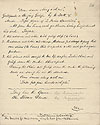 JSS0478 |
Come dance along with me | This excerpt is from a series of notebooks compiled by Skinner and his own dance teacher, William Scott. The notebooks were published under the title, A Guide to Fashionable Dancing. Come dance along with me Gallopade or Singing Galop. By W. Scott. Music...Fifth figure of Le Pacha Quadrilles. All form two lines, each gentleman having his partner at his side. Figure. 1. All advance and retire with galop step (4 bars) 2. Readvance and retire and change Partners but always keeping their own sides (4 bars). This is repeated until each gent. regain partner. 3. All stand still except the two top couples. Ladies chain and Galop down the centre. Others repeat. During the chain and Galop down the centre the following words are sung by all the dancers: 'Come dance along with me I will fill your hearts with glee.' Long live the Queen [a dance] The Flower Dance [Note]The music for this dance and for the Chimes of Dunkirk may be had from Mr Skinner. |
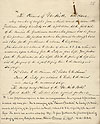 JSS0479 |
The Chimes of Dunkirk | This excerpt is from a series of notebooks compiled by Skinner and his own dance teacher, William Scott. The notebooks were published under the title, A Guide to Fashionable Dancing. *The Chimes of Dunkirk with chorus. Any number of couples form a circle round the room. The Gentleman having his Lady on the right arm. At the first note of the music the Gentleman makes a low formal bow in front of his partner - His partner makes a low formal curtsety (3 bars and 1 bar for the gentleman to return to his place. Join hands and advance to centre of dance 1.2.3.4 retire and readvance, upon retiring face the Lady on your left - Your partner face the Gentleman on his right. Stike the palm of the left hand with the fingers of the right (Keeping time to the music) and singing: 'Oh! Listen to the Chimes. Oh! Listen to the chimes.' Turn the Lady you advised to 'listen to the chimes' and during the movement sing: 'The merry, merry chimes of the Dunkirk Bells' Repeat until the Ladies have regained partners. *[Note] In our professional experience we have, on many occasions, been requested to give a dance in which all may join. The re-arranging of the 'Chimes of Dunkirk', the beauty of the music, and the simplicity of the figure has, we trust, reduced it to the capacity of the merest Tyro. The dance has another advantage - viz:- It gives Gentlemen the pleasure of dancing and singing with every Lady in the Room. This is Comme il faut. W.S. + J.S.S. |
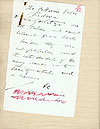 JSS0480 |
The Cellarius Valse, Redova and La Gorlitza | This excerpt is from a series of notebooks compiled by Skinner and his own dance teacher, William Scott. The notebooks were published under the title, A Guide to Fashionable Dancing. The Cellarius Valse Redova & La Gorlitza are all Valses and cannot be learnt from books besides they are not popular and the introduction fo too many dances into society entails more [illegible] on learners &c. [The following is strick through:] Mr Aitken [unclear] revise and add here. |
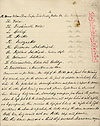 JSS0481 |
Valse, A Deux Temps, Trois Temps, Le Boston &C | This excerpt is from a series of notebooks complied by Skinner and his own dance teacher, Wiliam Scott. The notebooks were published under the title, A Guide to Fashionable Dancing. The terms Valse, A Deux Temps, Trois Temps, Le Boston &C The Valse, The Fashionable Valse, Le Galop, The Polka, The Mazurka, The German Schottische, The Highland Schottische...modern style, The Balmoral Schottische, The Cellarius Valse, Retira & La Gorlitza. As Varsovienne. A Round Dance for two. Commence as for Valse - the step of the Polka for the first bar turning half round, and for the second the foot is slidden noiselessly to the side the toe pointed in second position and pause; Repeat the same with the other foot, turning round into place - Eight times in all, each time turning half round. - Second step occupies four bars - The gentleman slides the left foot into the second position , and steps behind with right, and hops upon it, then carries the left foot behind the right into fifth position: the above is repeated, the lady doing the same movements. Both turn half round with one Polka step and pause. |
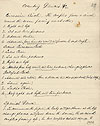 JSS0482 |
Page 1 of 2 Country Dances | This excerpt is from a series of notebooks compiled by Skinner and his own dance teacher, William Scott. The notebooks were published under the title, A guide to Fashionable Dancing. Circassion Circle. The couples form a circle round the room, facing each other. 1. Right ane left 2. Set and turn partners 3. Advance & retire 4. Advance, four hands round and pass on to next couple. Second Circassian Circle 1. Ladies Chain 2. Set and turn partners 3. Right and left 4. Hands four half round, and turn partners, changing places Gallopage Circle 1. Advance and retire, then advance and change partners (Galop Step.) 2. Same again; 3. Ladies Chain 4. Half right and left, and turn partners. Spanish Dance 1. To commence the figure, the lady and gentleman at the top change places, and face down the dance, the second couples facing up; the two couples set and change to each [continued JSS0483] |
prev 10 | 42 > 43 > 44 > 45 > 46 > 47 > 48 > 49 > 50 > 51 | next 10 of 90 pages


Historic Collections · Kings
College · Old Aberdeen · AB24 3SW
Tel:(0)44 1224 274312 · E-mail: scottskinner@abdn.ac.uk
Page design by IT Services Web Team